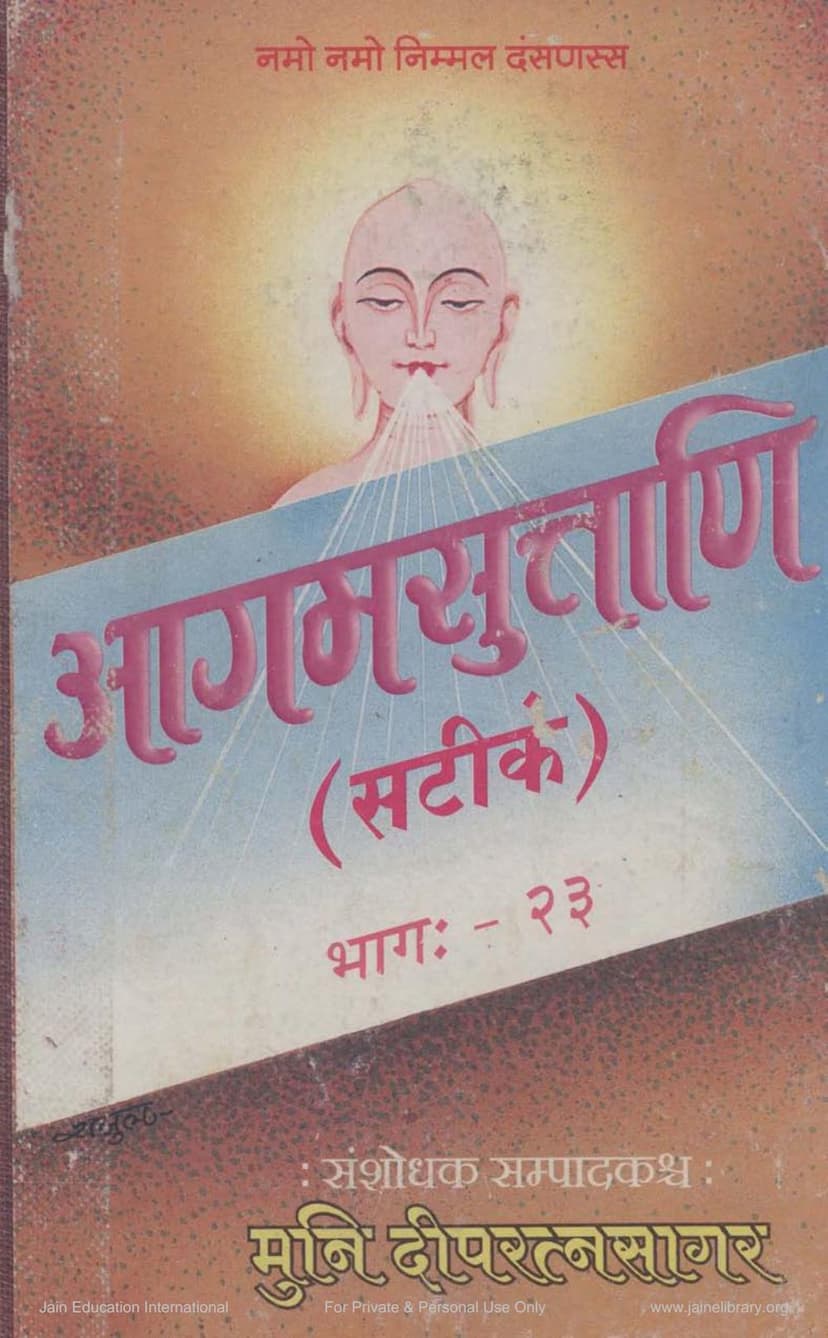Agam Sutra Satik 38 Jitkalpa ChhedSutra 5
Added to library: September 1, 2025

Summary
This text is the fifth section of the second volume (Bhag-23) of "Agam Sutra Satik," specifically focusing on the Jitkalpa ChhedSutra (38). The book was researched and edited by Muni Deepratnasagar and published by Agam Shrut Prakashan.
The Jitkalpa ChhedSutra is a foundational text within Jainism, dealing with disciplinary rules and expiations for monks. The provided pages offer a glimpse into its structure and content through the original Sanskrit/Prakrit text and its commentary (Churni).
Here's a breakdown of the key aspects based on the provided pages:
Overall Structure and Content:
- Title: The book is part of a larger series titled "Agam Suvani" (The Divine Words of Agams) and is specifically volume 23, covering Agam Sutra 37 and 38. Agam Sutra 38 is identified as the Jitkalpa ChhedSutra.
- Editor/Researcher: Muni Deepratnasagar is credited for researching and editing the text.
- Publisher: Agam Shrut Prakashan.
- Content Focus: The text primarily details the "Jitkalpa ChhedSutra" along with other significant ChhedSutras like "Dashashrutaskandha" and "Mahanishith."
- Commentary: The text includes a commentary (Churni) by Shri Siddhasen Gani.
Key Themes and Topics Covered (Based on the Index and Text):
The index (Page 3) provides a detailed breakdown of the topics covered within the three ChhedSutras presented in this volume. For the Jitkalpa ChhedSutra specifically, the index mentions:
- Mangalam (Invocation): Beginning with auspicious verses.
- Alochana Prayashchitta: Confession and expiation.
- Pratikramana Prayashchitta: Atonement and repentance.
- Tadubhaya Prayashchitta: Expiation for both.
- Viveka Prayashchitta: Expiation involving discernment.
- Kayotsarga Prayashchitta: Expiation through self-restraint or standing still.
- Tapa Prayashchitta: Expiation through austerities.
- Pratishevana: Re-offering or re-accepting.
- Chheda Prayashchitta: Expiation related to cutting off or separation.
- Moola Prayashchitta: Basic or fundamental expiation.
- Parashchita Prayashchitta: Ultimate or final expiation.
- Upasamhara (Conclusion): The concluding sections.
The initial verses (Page 6 onwards) present a devotional invocation, paying homage to various key figures in Jain tradition like the Ganadharas and the teachings themselves.
The main body of the text, starting from Page 7, delves into the commentary by Siddhasen Gani on the Jitkalpa. It discusses:
- The meaning of "Pravachana" (The Teaching): Defining it as the essence of Jain teachings, the path to liberation, and the source of all knowledge.
- The importance of expiation (Prayashchitta): Highlighting its role in purifying the soul from karmic impurities.
- Different types of expiation: Detailing various methods like confession (Alochana), repentance (Pratikramana), austerities (Tapa), etc.
- The context of expiation: Explaining when and how these expiations are to be performed, considering factors like the nature of the offense, the individual's spiritual state, and the specific circumstances.
- The concept of "Jeev-Vyavahar": This appears to be a central theme, referring to the correct procedure or conduct related to the soul's purification. The text contrasts it with other forms of "Vyavahar" (conduct or practice) like those based on scripture (Agam), authority (Aana), and memory (Dharana).
- Detailed discussion on various transgressions and their remedies: The commentary meticulously analyzes different types of faults (Atichara), their severity, and the corresponding expiations. This includes detailed explanations of actions related to speech, mind, body, and conduct.
- The role of the Acharya (spiritual preceptor): The text emphasizes the guidance and approval of the Acharya in administering and undertaking expiations.
- The concept of "Dappa" and "Kappiya": These likely refer to aspects of pride or arrogance in actions and the appropriateness of certain conduct.
- Penalties and Punishments: The text outlines specific forms of penance, including fasting, dwelling in specific places, and other forms of austerities, prescribed for different offenses.
- The importance of intention and knowledge: The commentary seems to indicate that the degree of expiation might also depend on whether the transgression was intentional or unintentional.
Key Figures Mentioned:
- Pancham Ganadhar Shri Sudharma Swami: The fifth Ganadhara, revered at the beginning.
- Jinbhadra Kshama Shraman: Author of the Jitkalpa ChhedSutra.
- Shri Siddhasen Gani: The author of the Churni (commentary).
- Various other revered monks and nuns: The dedication pages (Page 4-5) list numerous spiritual guides and patrons who supported the publication, highlighting the lineage and community involvement.
Publication Details:
- Price: Rs. 11000/-
- Contact: "Agam Aradhana Kendra," Ahmedabad.
- Date of Publication: April 14, 2000.
In essence, this volume of "Jitkalpa ChhedSutra" provides a detailed exposition of Jain monastic discipline, focusing on the various transgressions and the prescribed methods of purification and penance, guided by the profound commentary of Siddhasen Gani. The thoroughness of the index and the detailed explanations in the commentary suggest a comprehensive guide for monks and scholars of Jain philosophy.